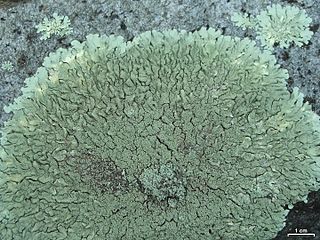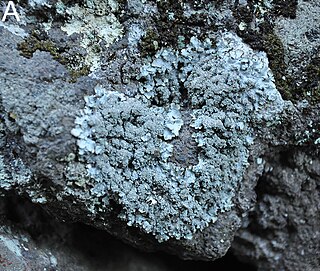
Melanohalea is a genus of foliose lichens in the family Parmeliaceae. It contains 30 mostly Northern Hemisphere species that grow on bark or on wood. The genus is characterised by the presence of pseudocyphellae, usually on warts or on the tips of isidia, a non-pored epicortex and a medulla containing depsidones or lacking secondary metabolites. Melanohalea was circumscribed in 2004 as a segregate of the morphologically similar genus Melanelia, which was created in 1978 for certain brown Parmelia species. The methods used to estimate the evolutionary history of Melanohalea suggest that its diversification primarily occurred during the Miocene and Pliocene epochs.

Punctelia is a genus of foliose lichens belonging to the large family Parmeliaceae. The genus, which contains about 50 species, was segregated from genus Parmelia in 1982. Characteristics that define Punctelia include the presence of hook-like to thread-like conidia, simple rhizines, and point-like pseudocyphellae. It is this last feature that is alluded to in the vernacular names speckled shield lichens or speckleback lichens.

Xanthoparmelia is a genus of foliose lichens in the family Parmeliaceae. This genus of lichen is commonly found in the United States, as well as Australia, New Zealand and Ecuador.

Imshaugia is a genus of seven species of foliose lichens in the family Parmeliaceae. They are commonly known as starburst lichens.
Parmotrema zicoi is a species of saxicolous lichen in the family Parmeliaceae. Found in Brazil, it was introduced as new to science in 2002.

Punctelia guanchica is a species of foliose lichen in the family Parmeliaceae that is only known from the Canary Islands. It is similar in appearance and morphology to the North American Punctelia rudecta, and was historically misidentified as that species until molecular phylogenetic evidence showed it to be a distinct species. It differs in having thicker isidia that develop from the centre of the pseudocyphellae, and it mainly grows on rocks.
Punctelia involuta is a species of foliose lichen in the family Parmeliaceae. Found in Brazil, it was described as a new species in 2010 by Luciana Canêz and Marcelli Marcelo. It is a member of the Punctelia microsticta species group, a set of related Punctelia lichens with a black lower surface and similar morphology. The type specimen of Punctelia involuta was collected in São Luiz do Paraitinga at the Serra do Mar State Park. In an open forest there it was found growing on mosses at the base of a thin, rotting Myrtaceae trunk; the elevation was 975 m (3,200 ft).
Punctelia purpurascens is a species of foliose lichen in the family Parmeliaceae. Found in Brazil, it was formally described as a new species in 2007 by lichenologists Marcelo Marcelli and Luciana da Silva Canêz. The type specimen was collected in the municipality of Vicara in the southern Brazilian state of Rio Grande do Sul. There it was found growing on a basaltic rock in an open field. The specific epithet purpurascens refers to the unusual K+ purple reaction of the medulla.
Punctelia constantimontium is a species of foliose lichen in the family Parmeliaceae. Its range includes South America, Africa, and Mexico, where it grows on bark and twigs.
Punctelia riograndensis is a species of foliose lichen in the family Parmeliaceae. Found in Africa and South America, it was formally described as a new species by Norwegian lichenologist Bernt Lynge in 1914, as Parmelia riograndensis. The type specimen was collected in 1892 from Porto Alegre Municipality in Rio Grande do Sul State (Brazil) by Swedish lichenologist Gustav Malme. In 1982, Hildur Krog circumscribed the genus Punctelia to contain Parmelia species with rounded pseudocyphellae, and P. riograndensis was one of the 22 species that she transferred to the new genus.
Punctelia tomentosula is a species of foliose lichen in the family Parmeliaceae. Found in Peru, it was described as a new species in 1999 by Japanese lichenologist Syo Kurokawa.
Punctelia jujensis is a species of foliose lichen in the family Parmeliaceae. It is found in Argentina and Brazil.
Punctelia subpraesignis is a species of foliose lichen in the family Parmeliaceae. It occurs in Mexico, South America, and East Africa, where it grows on bark and on rocks. Major characteristics of the lichen that distinguish it from other Punctelia species include the C+ and KC+ rose spot tests of the medulla, ascospores that are smaller than 20 μm, and unciform (hooklike) conidia.
Punctelia cedrosensis is a species of foliose lichen in the family Parmeliaceae. It is endemic to Mexico, where it grows on the bark of conifers.

Punctelia punctilla is a species of foliose lichen in the family Parmeliaceae. It is found in Africa, South America, and North America, where it grows on bark and on rocks. The main characteristics that distinguish Punctelia punctilla from other species of Punctelia are the presence of isidia on the thallus surface, a pale brown thallus undersurface, and the presence of lecanoric acid in the medulla.

Punctelia hypoleucites, commonly known as the southwestern speckled shield lichen, is a species of foliose (leafy) lichen in the family Parmeliaceae. First formally described by Finnish botanist William Nylander as a species of Parmelia, it was transferred to the genus Punctelia in 1982. The lichen is found in Africa, North America, and South America, where it grows on the bark of both hardwood and coniferous trees. Its greenish-grey thallus is covered with tiny white pseudocyphellae – minute holes in the thallus surface that facilitate gas exchange. Some macroscopic features that help distinguish this species from other related members of the genus include the presence and the structure of the apothecia, the absence of asexual surface propagules, and the light brown color of the thallus undersurface. Chemically, the presence of lecanoric acid in the medulla and atranorin in the cortex help distinguish it from lookalikes.

Punctelia bolliana, the eastern speckled shield lichen, is a species of foliose lichen in the family Parmeliaceae. It is found in North America, with a distribution extending from the Canadian province of Ontario south to the central and northeastern United States and Mexico. It grows on the bark of both deciduous trees and coniferous trees. The combination of characteristics that distinguishes this species from others in genus Punctelia are the absence of the vegetative propagules isidia and soralia, a pale brown lower thallus surface, and the presence of the secondary chemical protolichesterinic acid in the medulla.

Punctelia perreticulata is a widely distributed species of foliose lichen in the family Parmeliaceae. It occurs in Mediterranean Europe and Russia, North America, South America, Australia, and New Zealand, where it grows on rocks, bark, or wood. Its main distinguishing features are its thallus surface, marked with many shallow depressions, grooves, or pits, and sorediate pseudocyphellae. The lower side of the thallus is ivory to tan towards the centre and the major secondary metabolite in the medulla is lecanoric acid. A lookalike species with which it has been historically confused is Punctelia subrudecta; this lichen can be distinguished from Punctelia perreticulata by the texture of the thallus surface, or, more reliably, by the length of its conidia.

Punctelia graminicola is a species of foliose (leafy) lichen in the family Parmeliaceae. It grows on rocks, and, less frequently, on bark in North America, South America, and East Africa. It has a blue-grey thallus measuring up to about 15 cm (6 in), covered with tiny pores called pseudocyphellae. Sometimes the lichen forms small lobes that project out from the surface. Fruiting bodies are uncommon in this species; if present, they resemble small cups with a brown internal disc measuring 3–10 mm (0.1–0.4 in) in diameter. A lookalike species, Punctelia hypoleucites, is not readily distinguishable from Punctelia graminicola by appearance or habitat alone; these species can only be reliably differentiated by examining the length of their conidia.

Punctelia stictica is a species of foliose lichen in the family Parmeliaceae. It is widely distributed lichen, recorded in Africa, Europe, North America, South America, and Greenland. It is typically found growing on rocks.










